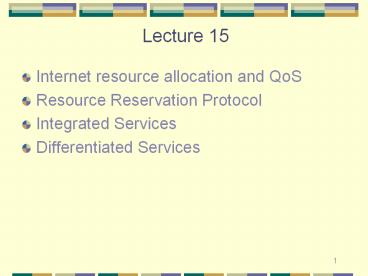Internet%20resource%20allocation%20and%20QoS - PowerPoint PPT Presentation
Title:
Internet%20resource%20allocation%20and%20QoS
Description:
A shaping buffer delays packets that do not confirm to the traffic shape. if ( L = C ) ... Weighted Fair Queuing practical version of GPS. ... – PowerPoint PPT presentation
Number of Views:24
Avg rating:3.0/5.0
Title: Internet%20resource%20allocation%20and%20QoS
1
Lecture 15
- Internet resource allocation and QoS
- Resource Reservation Protocol
- Integrated Services
- Differentiated Services
2
QoS in a datagram network?
- Packet Classification.
- Buffer acceptance algorithms.
- Explicit Congestion Notification.
- Flow measurements
3
A QoS Capable Router
4
Packet classification
- Identify the flow the packet belongs to.
- The edge routers may be able to do that.
- MPLS multi protocol label switch. Add an extra
header in front of the IP header. Now a router
decides the output link based upon the input link
and the MPLS header.
5
Buffer acceptance algorithms
- Tail Drop.
- RED Random Early Detection
- RIO Random Early Detection with In and Out
packet dropping strategies.
6
(No Transcript)
7
Explicit Congestion Notification (ECN)
- Routers could prevent congestion by informing the
source of the packets when they become lightly
congested, but before they start dropping
packets. - This strategy is called source quench.
8
Source quench
- A router sets a congestion notification flag in
the IP header to inform the destination that
signs of congestion are visible. - The destination informs the source by setting a
flag in the TCP header of segments carrying
acknowledgments.
9
Problems with ECN
- (1) TCP must be modified to support the new flag.
- (2) Routers must be modified to distinguish
between ECN-capable flows and those who do not
support ECN. - (3) IP must be modified to support the congestion
notification flag. - (4) TCP should allow the sender to confirm the
congestion notification to the receiver, because
acknowledgments could be lost.
10
Flow measurements
- How to choose the measurement interval to
accommodate bursty traffic? - Token bucket
11
The token bucket filter
- Characterized by (1) A token rate R, and (2)
The depth of the bucket, B - Basic idea the sender is allocated tokens at a
given rate and can accumulate tokens in the
bucket until the bucket is filled. To send a byte
the sender must have a token. The maximum burst
can be of size B because at most B token can be
accumulated.
12
Example
- Flow A generates data at a constant rate of 1
Mbps. Its filter will support a rate of 1 Mbps
and a bucket depth of 1 byte, - Flow B alternates between 0.5 and 2.0 Mbps. Its
filter will support a rate of 1 Mbps and a bucket
depth of 1 Mbps - Note a single flow can be described by many
token buckets.
13
Example
14
(No Transcript)
15
Token bucket
- L packet length
- C of tokens in the bucket
- --------------------------------------------------
- - if ( L lt C )
- accept the packet
- C C - L
- else
- drop the packet
16
A shaping buffer delays packets that do not
confirm to the traffic shape
- if ( L lt C )
- accept the packet
- C C - L
- else / the packet arrived early, delay it /
- while ( C lt L )
- wait
- transmit the packet
- C C - L
17
Packet Scheduling
- PS and GPS Processor Sharing Generalized
Processor Sharing - Round Robin, Weighted Round Robin
- Priority Scheduling
- Weighted Fair Queuing practical version of GPS.
Transmits packets in the order of their finishing
time.
18
Weighted queuing
19
RSVP- Resource Reservation Protocol
- Used to establish a path for a flow and reserve
resources along the path. - Requirements
- Accommodate faults soft state.
- Support unicast as well as multicast.
- PATH messages ? issued by sender includes TSpec
- RESV messages ? issued by the receiver includes
RSpec
20
RSVP
21
RSVP message
22
RSVP multicast
23
Integrated Services
- Support fine-grain QoS for individual flows.
- Mechanisms
- Specification of flow requirements - Flowspecs
- Admission decisions
- Resource reservation and policing
- Policy enforcement
24
Flowspecs
- TSpec specify the traffic characteristics
- Rspec describe services required from network.
25
Admission decisions
- Two classes
- Guaranteed Services based upon token buckets
- Controlled Load approximates a best effort
model in a lightly loaded network.
26
Integrated Service Router
27
Differentiated Services
- Two classes of traffic
- Regular
- Premium
- Edge routers mark the packets.
- Premium packets enjoy
- EF Expedited Forwarding
- AF Assured Forwarding






























